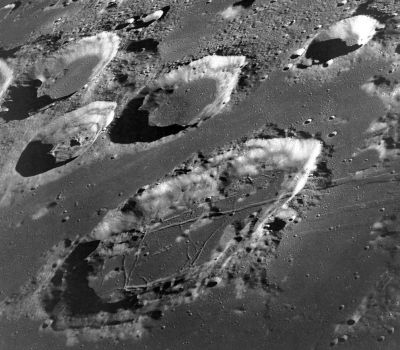Goclenius
Contents
Goclenius
|
Lat: 10.0°S, Long: 45.0°E, Diam: 72 km, Depth: 2.2 km, Rükl: 48 |

Apollo 8 AS08-13-2225
Which is one of the most well-known and most frequently reproduced orbital Apollo-Hasselblads of the moon's cratered surface. This extraordinary photograph was included on pages 620-621 of the article Apollo 8: A Most Fantastic Voyage by Lt. Gen. Sam C. Phillips (The Story of Apollo 8's Rendez-Vous with the Moon, NATIONAL GEOGRAPHIC, May 1969). Research Danny Caes.
Images
LPOD Photo Gallery Lunar Orbiter Images Apollo Images
- An interesting orbital pan-mosaic of images AS08-13-2215 to 2227 (the southwest region of Mare Fecunditatis) was created by David Woods and Frank O'Brien of the Apollo 8 Flight Journal. Note the location of Goclenius.
Maps
(LAC zone 79C1) LAC map Geologic map
Description
Description: Elger
(IAU Directions) GOCLENIUS.--A ring-plain, about 28 miles in diameter, bearing much resemblance to Plinius in form and size, and, like this formation, associated with a fine system of clefts. The lofty rampart, tolerably continuous on the E., is broken on the S.E. by a bright crater, and on the N.E. by a remarkable triangular depression. It is also traversed by a delicate valley extending from the crater on the S.E. to another on the N.E. border; and at a point a little E. of the first crater is dislocated by an intrusive mass of rock. There are several gaps on the W. and many spurs and irregularities in outline both within and without. A great portion of the N. wall is linear, and joins the W. section nearly at right angles. East of the triangular depression it appears to be partially wrecked, indications of the destruction being very evident if it be observed when the W. wall is near the morning terminator. The small bright central mountain is remarkable for its curious oblong shadow. Two clefts traverse the interior of Goclenius. (1) Originates at the S. wall, W. of the crater, and runs W. of the central mountain to the N. wall; (2) crosses the debris of the ruined N.E. border, runs parallel to the first, and extends nearly to the centre of the floor, (1) Re-appears at the foot of a mound outside the N. wall, and, after crossing the outer E. slope of the great ring-plain on the N.E. wall of Guttemberg, runs to the E. side of an oblong formation N. of it. There are two other clefts, closely parallel and E. of this, traversing the Mare, and terminating among the mountains on the N.E. These are crossed at right angles by what appears to be a "fault," running in a N.E. direction from the E. side of Guttemberg.
Description: Wikipedia:
Additional Information
- Depth data from Kurt Fisher database
- Pike, 1976: 2.2 km
- Westfall, 2000: 2.2 km
- Viscardy, 1985: 1.5 km
- Cherrington, 1969: 1.85 km
- Goclenius UA and UB (names no longer recognized by the IAU) are thermal anomaly craters, implying youthful ages - Moore et al, 1980
Nomenclature
- Named for Rudolf Gockel (1572-1621), a German physicist, doctor, mathematician.
- The name Goclenius, for the present crater, was introduced by Riccioli.
- As noted by astronomical historian Robert Garfinkle, Riccioli mentions Rodulphus Goclenius on page XLIV of his book, and identifies him as the Doctor of Medicine at Marburg University who wrote Urania cum geminis filiabus (1615). Although that person had a father of the same name, who outlived him and who taught at the same university and wrote about astronomy, the reference is clearly to the son.
- Goclenius became Catalog Number 4325 in Mary Blagg's Collated List and in the original IAU nomenclature of Named Lunar Formations.
- Goclenius Delta (the hill southeast of Amontons, west-northwest of Ibn Battuta).
- The hill northeast of Goclenius seems to have been called Epsilon (Goclenius Epsilon).
APOD Articles
https://apod.nasa.gov/apod/ap180303.html
Southwest Mare Fecunditatis (Apollo 8, anaglyph from Patrick Vantuyne).
LPOD Articles
Land of Milk, Honey and Rilles Go See 'Em - They are Gut
Bibliography
APOLLO OVER THE MOON: A VIEW FROM ORBIT, Chapter 6: Rimae (Part 3: Straight Rimae), Figure 209.